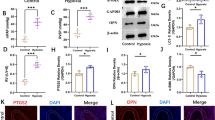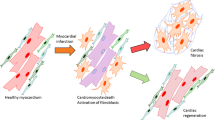Abstract
An innovative approach for cardiac regeneration following injury is to induce endogenous cardiomyocyte (CM) cell cycle re-entry. In the present study, CMs from adult rat hearts were isolated and transfected with cel-miR-67 (control) and rno-miR-210. A significant increase in CM proliferation and mono-nucleation were observed in miR-210 group, in addition to a reduction in CM size, multi-nucleation, and cell death. When compared to control, β-catenin and Bcl-2 were upregulated while APC (adenomatous polyposis coli), p16, and caspase-3 were downregulated in miR-210 group. In silico analysis predicted cell cycle inhibitor, APC, as a direct target of miR-210 in rodents. Moreover, compared to control, a significant increase in CM survival and proliferation were observed with siRNA-mediated inhibition of APC. Furthermore, miR-210 overexpressing C57BL/6 mice (210-TG) were used for short-term ischemia/reperfusion study, revealing smaller cell size, increased mono-nucleation, decreased multi-nucleation, and increased CM proliferation in 210-TG hearts in contrast to wild-type (NTG). Likewise, myocardial infarction (MI) was created in adult mice, echocardiography was performed, and the hearts were harvested for immunohistochemistry and molecular studies. Compared to NTG, 210-TG hearts showed a significant increase in CM proliferation, reduced apoptosis, upregulated angiogenesis, reduced infarct size, and overall improvement in cardiac function following MI. β-catenin, Bcl-2, and VEGF (vascular endothelial growth factor) were upregulated while APC, p16, and caspase-3 were downregulated in 210-TG hearts. Overall, constitutive overexpression of miR-210 rescues heart function following cardiac injury in adult mice via promoting CM proliferation, cell survival, and angiogenesis.
Key messages
-
MiRNA-210 transfected adult rat CMs show proliferation and reduced cell death in vitro.
-
Cell cycle inhibitor APC is a target of miR-210.
-
MiR-210 overexpressing (210-TG) mouse hearts show CMs cell cycle re-entry and survival post myocardial injury.
-
210-TG mice show significant neovascularization and angiogenic potential post myocardial infarction.
-
210-TG hearts show reduced infarct size following ischemic injury.








Similar content being viewed by others
References
Mozaffarian D, Benjamin EJ, Go AS, Arnett DK, Blaha MJ, Cushman M, de Ferranti S, Després JP, Fullerton HJ, Howard VJ et al (2015) Heart disease and stroke statistics—2015 update: a report from the American Heart Association. Circulation 131:29
Doppler SA, Deutsch MA, Lange R, Krane M (2013) Cardiac regeneration: current therapies-future concepts. J Thorac Dis 5:683–697
Porrello ER, Mahmoud AI, Simpson E, Hill JA, Richardson JA, Olson EN, Sadek HA (2011) Transient regenerative potential of the neonatal mouse heart. Science 331:1078–1080
Eulalio A, Mano M, Dal Ferro M, Zentilin L, Sinagra G, Zacchigna S, Giacca M (2012) Functional screening identifies miRNAs inducing cardiac regeneration. Nature 492:376–381
Liang D, Li J, Wu Y, Zhen L, Li C, Qi M, Wang L, Deng F, Huang J, Lv F et al (2015) miRNA-204 drives cardiomyocyte proliferation via targeting Jarid2. Int J Cardiol 201:38–48
Pandey R, Ahmed RP (2015) MicroRNAs inducing proliferation of quiescent adult cardiomyocytes. Cardiovasc Regen Med 2:e519
Nair N, Gongora E (2014) MicroRNAs as therapeutic targets in cardiomyopathies: myth or reality? Biomol Concepts 5:439–448
Palacin M, Reguero JR, Martin M, Diaz Molina B, Moris C, Alvarez V, Coto E (2011) Profile of microRNAs differentially produced in hearts from patients with hypertrophic cardiomyopathy and sarcomeric mutations. Clin Chem 57:1614–1616
Li T, Cao H, Zhuang J, Wan J, Guan M, Yu B, Li X, Zhang W (2011) Identification of miR-130a, miR-27b and miR-210 as serum biomarkers for atherosclerosis obliterans. Clin Chim Acta 412:66–70
Bostjancic E, Zidar N, Glavac D (2009) MicroRNA microarray expression profiling in human myocardial infarction. Dis Markers 27:255–268
Thum T, Galuppo P, Wolf C, Fiedler J, Kneitz S, van Laake LW, Doevendans PA, Mummery CL, Borlak J, Haverich A et al (2007) MicroRNAs in the human heart: a clue to fetal gene reprogramming in heart failure. Circulation 116:258–267
van Rooij E, Sutherland LB, Liu N, Williams AH, McAnally J, Gerard RD, Richardson JA, Olson EN (2006) A signature pattern of stress-responsive microRNAs that can evoke cardiac hypertrophy and heart failure. Proc Natl Acad Sci U S A 103:18255–18260
Hu S, Huang M, Li Z, Jia F, Ghosh Z, Lijkwan MA, Fasanaro P, Sun N, Wang X, Martelli F, Robbins RC, Wu JC (2010) MicroRNA-210 as a novel therapy for treatment of ischemic heart disease. Circulation 122:S124–S131
Devlin C, Greco S, Martelli F, Ivan M (2011) miR-210: more than a silent player in hypoxia. IUBMB Life 63:94–100
Giannakakis A, Sandaltzopoulos R, Greshock J, Liang S, Huang J, Hasegawa K, Li C, O'Brien-Jenkins A, Katsaros D, Weber BL et al (2008) miR-210 links hypoxia with cell cycle regulation and is deleted in human epithelial ovarian cancer. Cancer Biol Ther 7:255–264
Hwang HW, Baxter LL, Loftus SK, Cronin JC, Trivedi NS, Borate B, Pavan WJ (2014) Distinct microRNA expression signatures are associated with melanoma subtypes and are regulated by HIF1A. Pigment Cell Melanoma Res 27:777–787
Masliah-Planchon J, Pasmant E, Luscan A, Laurendeau I, Ortonne N, Hivelin M, Varin J, Valeyrie-Allanore L, Dumaine V, Lantieri L et al (2013) MicroRNAome profiling in benign and malignant neurofibromatosis type 1-associated nerve sheath tumors: evidences of PTEN pathway alterations in early NF1 tumorigenesis. BMC Genomics 14:473
Rothe F, Ignatiadis M, Chaboteaux C, Haibe-Kains B, Kheddoumi N, Majjaj S, Badran B, Fayyad-Kazan H, Desmedt C, Harris AL et al (2011) Global microRNA expression profiling identifies MiR-210 associated with tumor proliferation, invasion and poor clinical outcome in breast cancer. PLoS One 6:e20980
Tsuchiya S, Fujiwara T, Sato F, Shimada Y, Tanaka E, Sakai Y, Shimizu K, Tsujimoto G (2011) MicroRNA-210 regulates cancer cell proliferation through targeting fibroblast growth factor receptor-like 1 (FGFRL1). J Biol Chem 286:420–428
Wang J, Zhao J, Shi M, Ding Y, Sun H, Yuan F, Zou Z (2014) Elevated expression of miR-210 predicts poor survival of cancer patients: a systematic review and meta-analysis. PLoS One 9:e89223
Zhang Z, Sun H, Dai H, Walsh RM, Imakura M, Schelter J, Burchard J, Dai X, Chang AN, Diaz RL et al (2009) MicroRNA miR-210 modulates cellular response to hypoxia through the MYC antagonist MNT. Cell Cycle 8:2756–2768
Camps C, Buffa FM, Colella S, Moore J, Sotiriou C, Sheldon H, Harris AL, Gleadle JM, Ragoussis J (2008) hsa-miR-210 is induced by hypoxia and is an independent prognostic factor in breast cancer. Clin Cancer Res 14:1340–1348
Huang X, Ding L, Bennewith KL, Tong RT, Welford SM, Ang KK, Story M, Le QT, Giaccia AJ (2009) Hypoxia-inducible mir-210 regulates normoxic gene expression involved in tumor initiation. Mol Cell 35:856–867
Huang X, Le QT, Giaccia AJ (2010) MiR-210—micromanager of the hypoxia pathway. Trends Mol Med 16:230–237
Nakada Y, Canseco DC, Thet S, Abdisalaam S, Asaithamby A, Santos CX, Shah AM, Zhang H, Faber JE, Kinter MT et al (2017) Hypoxia induces heart regeneration in adult mice. Nature 541:222–227
Baker M, Robinson SD, Lechertier T, Barber PR, Tavora B, D'Amico G, Jones DT, Vojnovic B, Hodivala-Dilke K (2011) Use of the mouse aortic ring assay to study angiogenesis. Nat Protoc 7:89–104
Ahuja P, Sdek P, MacLellan WR (2007) Cardiac myocyte cell cycle control in development, disease, and regeneration. Physiol Rev 87:521–544
Bicknell KA, Coxon CH, Brooks G (2007) Can the cardiomyocyte cell cycle be reprogrammed? J Mol Cell Cardiol 42:706–721
van Amerongen MJ, Engel FB (2008) Features of cardiomyocyte proliferation and its potential for cardiac regeneration. J Cell Mol Med 12:2233–2244
Ali SR, Hippenmeyer S, Saadat LV, Luo L, Weissman IL, Ardehali R (2014) Existing cardiomyocytes generate cardiomyocytes at a low rate after birth in mice. Proc Natl Acad Sci U S A 111:8850–8855
Borchardt T, Braun T (2007) Cardiovascular regeneration in non-mammalian model systems: what are the differences between newts and man? Thromb Haemost 98:311–318
Gamba L, Harrison M, Lien CL (2014) Cardiac regeneration in model organisms. Curr Treat Options Cardiovasc Med 16:288
Lien CL, Harrison MR, Tuan TL, Starnes VA (2012) Heart repair and regeneration: recent insights from zebrafish studies. Wound Repair Regen 20:638–646
Chen J, Huang ZP, Seok HY, Ding J, Kataoka M, Zhang Z, Hu X, Wang G, Lin Z, Wang S et al (2013) Mir-17-92 cluster is required for and sufficient to induce cardiomyocyte proliferation in postnatal and adult hearts. Circ Res 112:1557–1566
Kuhn B, del Monte F, Hajjar RJ, Chang YS, Lebeche D, Arab S, Keating MT (2007) Periostin induces proliferation of differentiated cardiomyocytes and promotes cardiac repair. Nat Med 13:962–969
Zhou J, Ahmad F, Parikh S, Hoffman NE, Rajan S, Verma VK, Song J, Yuan A, Shanmughapriya S, Guo Y et al (2016) Loss of adult cardiac myocyte GSK-3 leads to mitotic catastrophe resulting in fatal dilated cardiomyopathy. Circ Res 118:1208–1222
Xu HL, Xu WH, Cai Q, Feng M, Long J, Zheng W, Xiang YB, Shu XO (2009) Polymorphisms and haplotypes in the caspase-3, caspase-7, and caspase-8 genes and risk for endometrial cancer: a population-based, case-control study in a Chinese population. Cancer Epidemiol Biomark Prev 18:2114–2122
Putinski C, Abdul-Ghani M, Stiles R, Brunette S, Dick SA, Fernando P, Megeney LA (2013) Intrinsic-mediated caspase activation is essential for cardiomyocyte hypertrophy. Proc Natl Acad Sci U S A 110:E4079–E4087
Eken SM, Jin H, Chernogubova E, Li Y, Simon N, Sun C, Korzunowicz G, Busch A, Bäcklund A, Österholm C et al (2017) MicroRNA-210 enhances fibrous cap stability in advanced atherosclerotic lesions. Circ Res 120:633–644
Ye B, Hou N, Xiao L, Xu Y, Boyer J, Xu H, Li F (2015) APC controls asymmetric Wnt/beta-catenin signaling and cardiomyocyte proliferation gradient in the heart. J Mol Cell Cardiol 89:287–296
McConnell BB, Gregory FJ, Stott FJ, Hara E, Peters G (1999) Induced expression of p16(INK4a) inhibits both CDK4- and CDK2-associated kinase activity by reassortment of cyclin-CDK-inhibitor complexes. Mol Cell Biol 19:1981–1989
Tang JM, Wang JN, Zhang L, Zheng F, Yang JY, Kong X, Guo LY, Chen L, Huang YZ, Wan Y et al (2011) VEGF/SDF-1 promotes cardiac stem cell mobilization and myocardial repair in the infarcted heart. Cardiovasc Res 91:402–411
Dang K, Myers KA (2015) The role of hypoxia-induced miR-210 in cancer progression. Int J Mol Sci 16:6353–6372
Dutta S, Sengupta P (2015) Men and mice: relating their ages. Life Sci 152:244–248
Acknowledgements
This work was supported by the grant from National Institutes of Health (NIH) HL106190-01 to Dr. Rafeeq Habeebahmed and NIH GM103638 to Dr. Arghya Paul.
Author information
Authors and Affiliations
Corresponding author
Ethics declarations
All animal have been utilized in accordance with the protocol approved by the Institutional Animal Care and Use Committee (IACUC), and the studies have been performed in accordance with the ethical standards. The manuscript does not contain any clinical studies or patient data.
Conflict of interest
The authors declare that they have no conflict of interest.
Electronic supplementary material
ESM 1
(PDF 801 kb)
Rights and permissions
About this article
Cite this article
Arif, M., Pandey, R., Alam, P. et al. MicroRNA-210-mediated proliferation, survival, and angiogenesis promote cardiac repair post myocardial infarction in rodents. J Mol Med 95, 1369–1385 (2017). https://doi.org/10.1007/s00109-017-1591-8
Received:
Revised:
Accepted:
Published:
Issue Date:
DOI: https://doi.org/10.1007/s00109-017-1591-8




